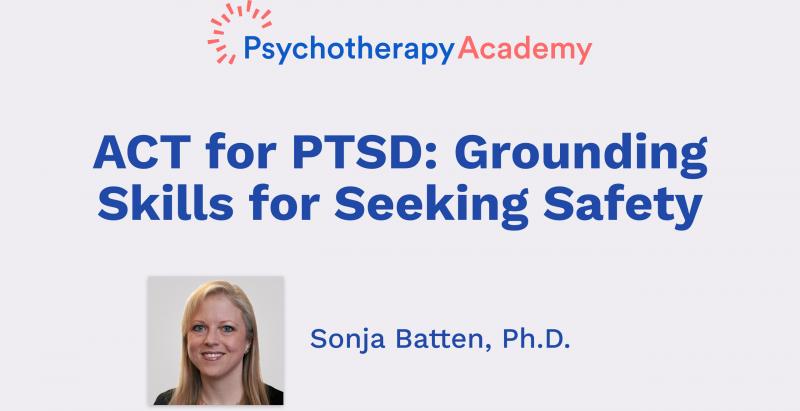ACT and Exposure Therapy for PTSD: Practical Tools with Dr. Sonja Batten by Psychotherapy Academy
ACT and Exposure Therapy for PTSD: Practical Tools with Dr. Sonja Batten by Psychotherapy AcademyACT for PTSD: The Case of Deborah, an Army Veteran
In this clinical case, Dr. Sonja Batten talks about a client presenting with heightened anxiety symptoms who met the criteria for PTSD and panic disorder. She applies the ACT framework to conceptualize the case and develop a treatment structure based on the hexaflex model. This model includes behavioral tracking, acceptance metaphors, values clarification, and differing levels of exposure.
<> ACT for PTSD: Grounding Skills for Seeking Safety
Learn practical exercises for the three categories of grounding skills – physical, mental, and soothing – and understand the role of purposeful distraction. Here are some highlights we've extracted from the video:
1. Grounding skills are basic coping techniques for trauma survivors and are divided into physical, mental, and soothing grounding.
2. Avoidance is problematic when the individual does it in autopilot mode rather than being mindful.
3. The immediate goal of grounding skills is that the client can get through an upsetting moment without worsening the situation.
<> ACT Work on Trauma Memories: Exposure Hierarchy
Explore the differences between traditional and ACT-based exposure, and learn how to apply the exposure hierarchy to a client with PTSD. Here are some highlights we've extracted from the video:
1. Use an exposure hierarchy to prioritize a client’s traumatic events by level of distress from lowest to highest.
2. Deborah chose to use written exposure due to her journalism background, rather than oral or via recordings.
3. Traditional exposure is based on habituation and attenuation of distress, whereas ACT-based exposure focuses on awareness and mindfulness.
<> ACT for PTSD: Nightmare Rehearsal Treatment
Dr. Sonja Batten applies nightmare rehearsal treatment to Deborah, a client with PTSD. This exposure helps create a healthy distance from the traumatic event. Here are some highlights we've extracted from the video:
1. Nightmare rehearsal treatment is a type of exposure that helps reduce the severity and frequency of nightmares.
2. It involves writing and rewriting a nightmare’s content in detail and changing one thing that can make the client aware that it’s not real.
3. This technique can be adapted to fit the client’s needs; for example, when nightmares are about actual traumatic events and the outcome cannot be changed without invalidating the client.


